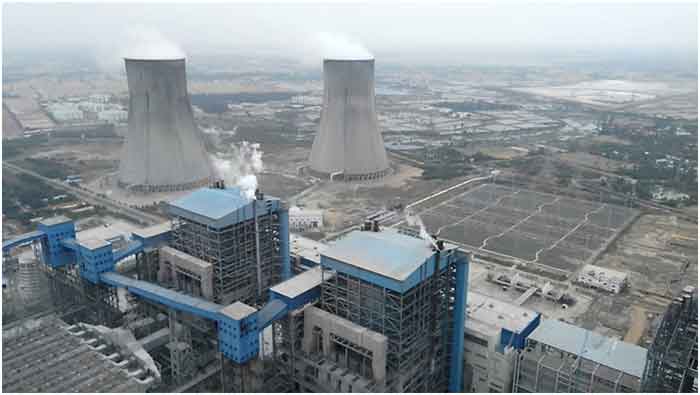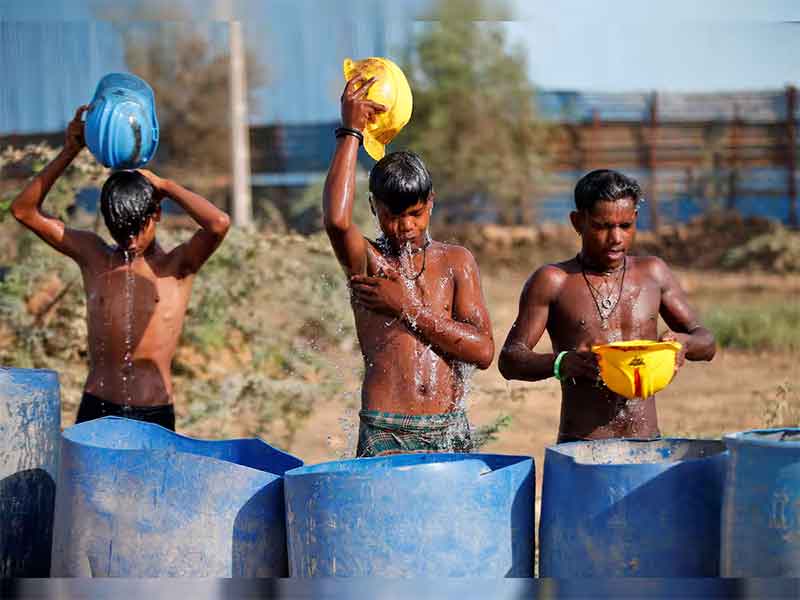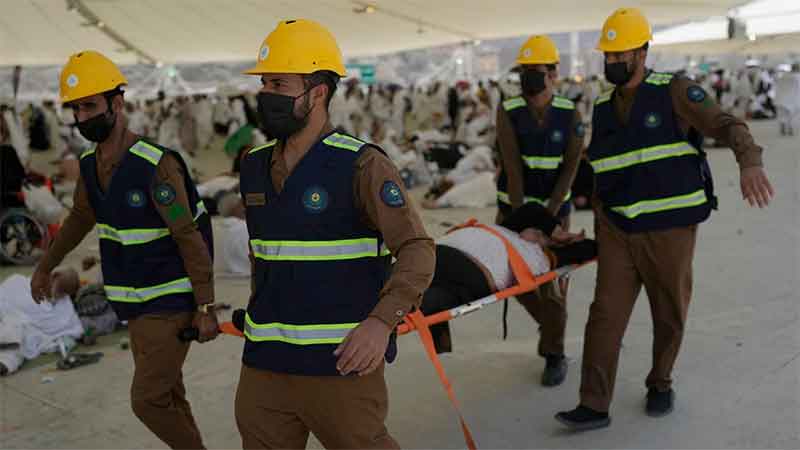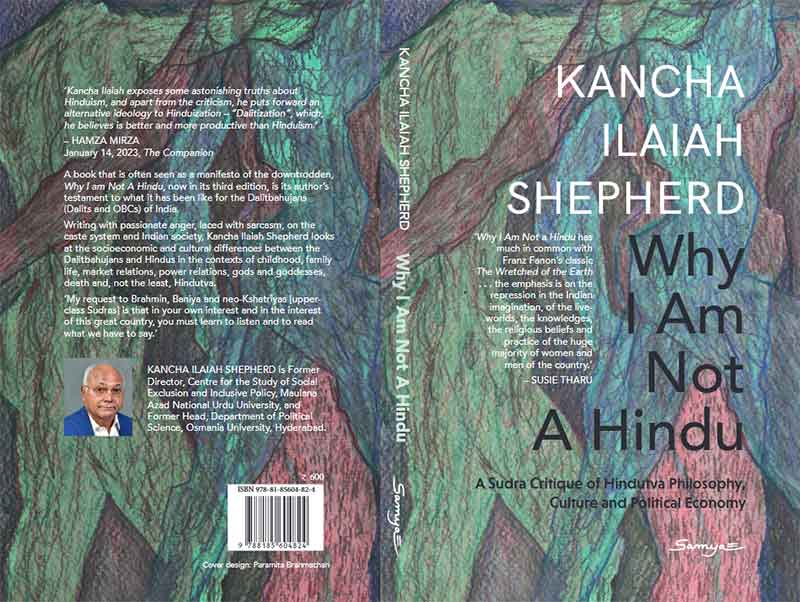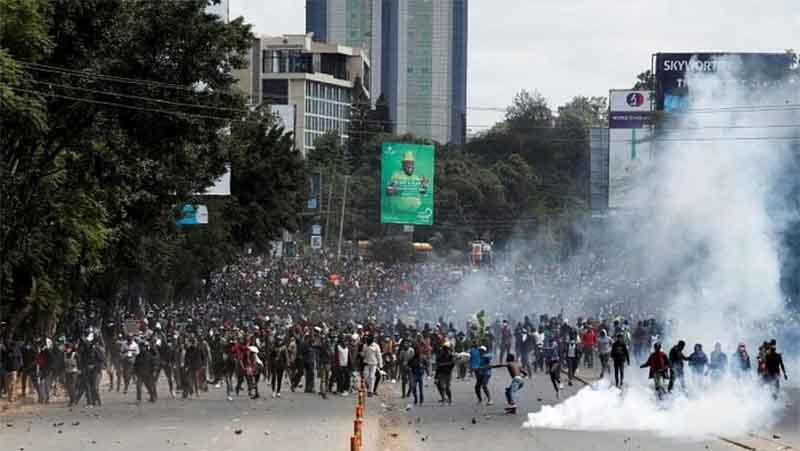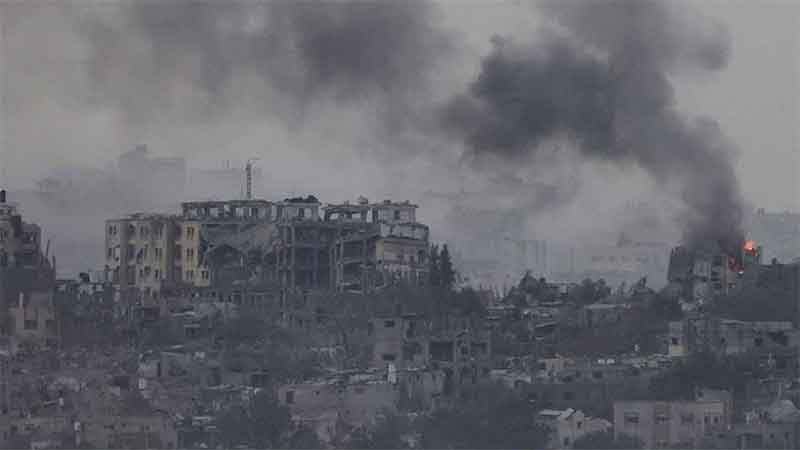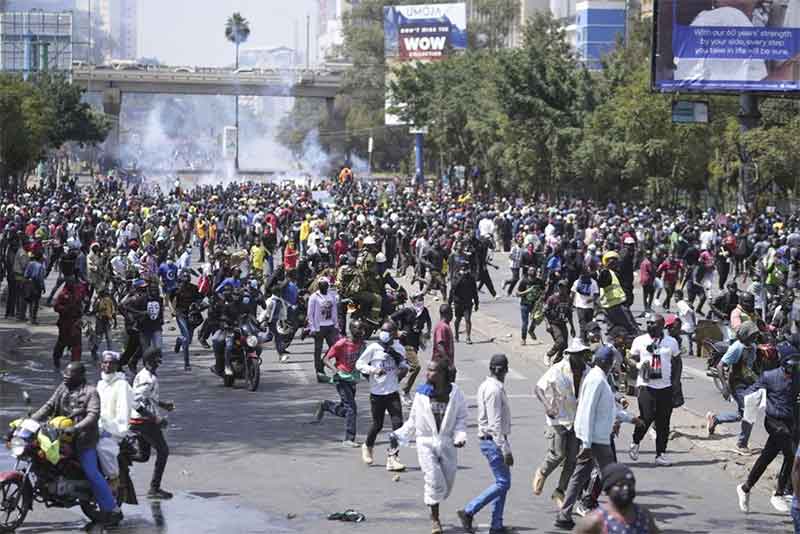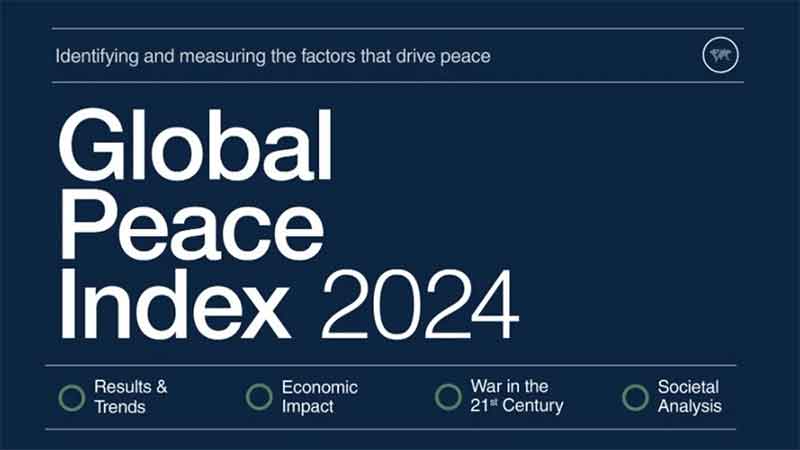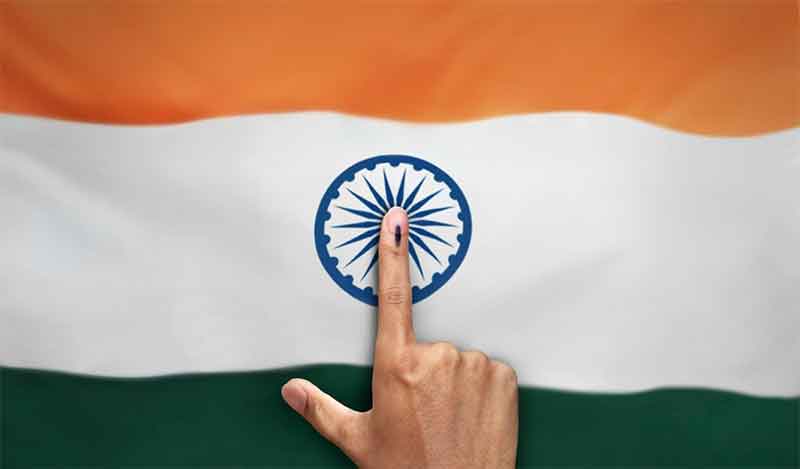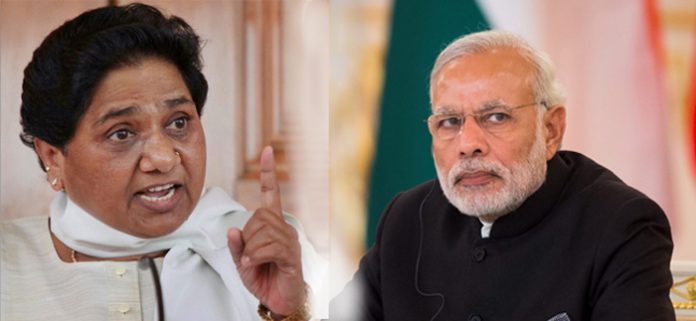South Asia is a vast land half the size of Continental Europe. Afghanistan, Bangladesh, Bhutan, India, Maldives Nepal, Pakistan and Sri Lanka lie in South Asia and account for 25% of the world’s population. South Asia is bound by the Indian Ocean in the south and the Himalayas to the north.
Shared Culture—A Good Reason to Form a South Asian Union
South Asians share common roots going back 9 millennia. Neolithic culture spread throughout South Asia between 7,000 and 3,500 BCE. Subsequently, the arts, architecture, crafts, urbanization, trade and governance flourished in the Indus Valley Civilization in the Northwest of South Asia between 3,300 and 1,300 BCE, making it one of the world’s principal civilization cradles. By 1200 BCE, the Vedic culture spread to the Gangetic plain.
Historically South Asia was influenced by its neighbours, particularly from its west and north, resulting in creating enormous diversity throughout the Indian Subcontinent. Yet this mosaic of varying cultures merged seamlessly into one another in space and time, creating what is known as a South Asian culture.
Pakistan’s western provinces of Baluchistan and Khyber Pakhtunkhwa have a Persian heritage, whereas its eastern provinces, Punjab and Sindh, are more akin to India’s Punjab and Rajasthan. Bangladesh and West Bengal share a common language and culture. Nepal, Bhutan and Sikkim derive their cultural heritage from both India and Tibet. Sri Lanka draws its traditions from both India and Southeast Asia. North and South India are culturally and linguistically closer to their neighbours than to each other.
As they have common ancestry, several scores of languages and hundreds of dialects are spoken in South Asia, often across countries. Punjabi is spoken in Punjab states of Pakistan and India. Bangla is spoken in Bangladesh, West Bengal and Tripura. Tamil is spoken in Tamil Nadu and Sri Lanka. Hindi/Urdu is spoken in North India and Pakistan. Sinhala, spoken in Sri Lankan, is written in a script derived from the Kadamba-Pallava alphabet.
The same religious and cultural festivals are celebrated in several countries. Deepawali, Dussera, Ganesh Chaturthi and Holi are celebrated all over India and Nepal and by Hindus in Bangladesh, Sri Lanka, Bhutan and Pakistan. Id is celebrated in Afghanistan, Pakistan, Bangladesh, Maldives, India, Nepal and Sri Lanka.
South Asia’s music is as diverse as its languages. The foundations of the important forms of South Asian classical music—Hindustani and Carnatic, can be traced back to the Vedic times. Hindustani classical music is popular in North India, Pakistan and Bangladesh while Carnatic classical music is commonly heard in South India. Hundreds of other music forms enjoy wide patronage, often across national borders.
Like music, South Asian cuisine is very diverse. Yet, South Asian cuisine is recognized for its distinctive style of cooking and use of herbs such as cardamom, turmeric, cinnamon, and cumin seeds that are unique to South Asia. Indigenous sports such as kho-kho and kabaddi are played in India, Pakistan, Bangladesh and Nepal.
A shared history and a huge overlap of culture and traditions are strong reasons for South Asian countries to forge closer ties by forming a South Asian Union that is akin to the European Union. A South Asian Union would accelerate the socio-economic development in all of South Asia.
Future Environmental Challenges–A Better Reason for a South Asian Union
While a shared history and culture are good reasons to form a South Asian Union, the environmental challenges that South Asia will shortly face are an even stronger reason to form such a union as these challenges can be better addressed collectively through cooperation. The two major environmental challenges that South Asia will face in future are environmental conflicts over inter-state river water sharing and transboundary air pollution, and the climate crisis.
Inter-state River Water Sharing
Many of South Asia’s big rivers are inter-state rivers. The Indus and its tributaries, Jhelum, Chenab, Ravi, Beas, and Sutlej, flow from India into Pakistan. The Karnali, Gandagi and Kosi flow from Nepal into India. The Brahmaputra (Yarlung Zangbo in Tibet) flows from Tibet into India. The Ganga, Brahmaputra and Teesta flow from India into Bangladesh. These glacier and snow-fed rivers originate in the Himalayas and are the lifeline for South Asia that is above the Tropic of Cancer.
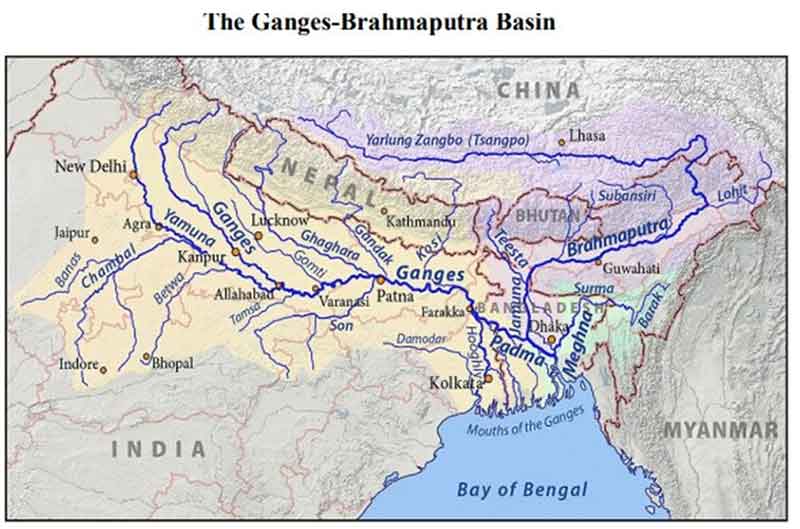
South Asia is largely an agrarian society that requires a considerable amount of water for its farmlands. Ground water has been overexploited and surface water is in high demand. With a moderate population growth and a rapid industrialization in some countries, water demand in South Asia will outstrip water supply in the coming decades. This sets the stage for inter-state water conflicts.
China’s plans to build dams on the Yarlung Zangbo (Brahmaputra) in Tibet have raised apprehensions in India and Bangladesh that this will decrease the flow in the Brahmaputra after the Himalayan glaciers melt. Dams in Yarlung Zangbo in Tibet would give China the ability to divert water away from the Brahmaputra.
Of the 54 rivers that India and Bangladesh share, a water-sharing treaty has been signed only for one river, the Ganga. A treaty for sharing Teesta waters, one of the three most important rivers shared by India and Bangladesh, under negotiation since 2011, has remained elusive. The Bangladesh Government has sought a water-sharing agreement for the Teesta along the lines of the 1996 water-sharing treaty of the Ganga River waters between India and Bangladesh. West Bengal, through which the Teesta flows before entering Bangladesh, feels that the proposal for India and Bangladesh to get 42.5% and 37.5%, respectively, of Teesta’s lean season flow, will be not in the interest of West Bengal farmers.
The Himalayas act like a water tower for Tibet, Pakistan, Northern India, Nepal, Bhutan and Bangladesh. Three major rivers—Ganga, Brahmaputra and the Indus, and their tributaries, drain the Himalayas to feed water to these countries. Nepal’s 6,000 rivers, with a length of 45,000 km and an annual discharge of 220 bcm, drain into India and Bangladesh before flowing into the Bay of Bengal. Nepal occupies 15% of the Ganges basin area but supplies 38% of its water.
India and Nepal signed a treaty in 1920 to construct the Sarada Barrage in the Mahakali River. Later other agreements were signed for water-sharing, flood control and project development—The Kosi Agreement in 1954, the Gandak Agreement in 1959, the Tanakpur MoU in 1991 and the Mahakali Treaty in 1996. These agreements were never implemented fully. Domestic constituents in both countries had reservations about the agreements and have made persistent demands to repeal or revise these treaties.
The 1960 Indus Water Treaty between India and Pakistan, brokered by the World Bank, gave India the water in the three southern rivers—Sutlej, Beas and Ravi—amounting to 29% of the water available in the Indus water system. Pakistan got 71% of the Indus water system from the three northern rivers—Indus, Jhelum and Chenab. India could however use run-of-the-river water from the northern rivers for agricultural uses, hydropower generation, and domestic and non-consumptive purposes.
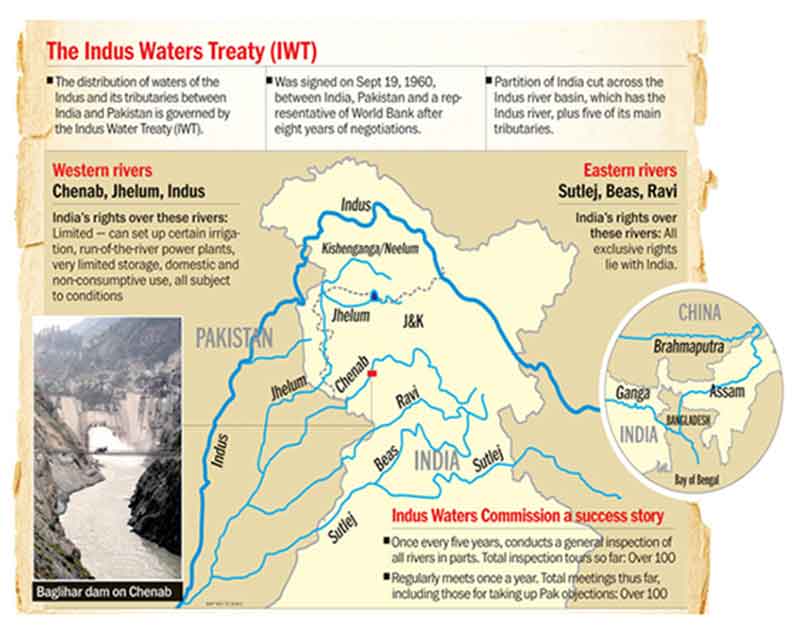

After the 2016 Uri terrorist attack, India threatened to withdraw from the Indus Waters Treaty. After the 2019 Pulwama attack, Nitin Gadkari, Minister for Roads and Water Resources stated that all water presently flowing into Pakistan in the three southern rivers will be diverted to Punjab, Haryana and Rajasthan.
Shapur Kandi Dam on the Ravi River
Recently, India completed constructing the Shahpur Kandi dam on the Chenab River. Downstream of the dam, there will be very little water flow in the Ravi when it enters Pakistan. There is no formal treaty that regulates the distribution of water from the Kabul River between Pakistan and Afghanistan.
In a warming world, as the glaciers melt, water flow in the inter-state rivers will initially increase, causing floods of the sort that Pakistan experienced in 2022. Subsequently, water flow will decrease and both the upper and the lower riparian countries will be affected. However, the upper riparian states have the option of building dams and storing and diverting water, which if they did, would impact the lower riparian countries further. Surely, the stage is set for increased conflict over inter-state river waters in South Asia.
Transboundary Transport of Air Pollution
Over the last two decades, South Asia’s economy has grown at 6% pa. As fossil fuels have energized this growth, emissions of criteria pollutants too have grown (SO2 at 4.4% pa and NO2 at 2.9% pa).
GDP and acidic gas emissions growth in South Asia—2002-2022
| Country/ Region | Nominal GDP US$ Bill ($ 2015) | CAGR GDP 2002-2022 (%) | SO2 emissions 2022 MT | CAGR SO2 emissions 2002-2022 (%) | NO2 emissions 2022 MT | CAGR NO2 emissions 2002-2022 (%) |
| India | 2,960.0 | 6.3% | 11.24 | 4.3% | 9.35 | 2.7% |
| Pakistan | 399.9 | 4.2% | 2.07 | 3.9% | 1.67 | 2.6% |
| Bangladesh | 305.4 | 6.3% | 0.64 | 10.9% | 1.05 | 5.3% |
| Sri Lanka | 88.5 | 4.2% | 0.16 | 1.9% | 0.27 | 2.0% |
| Nepal | 33.1 | 4.4% | 0.09 | 6.8% | 0.23 | 4.3% |
| Afghanistan | 16.4 | 4.1% | 0.03 | 12.2% | 0.39 | 7.6% |
| Maldives | 5.8 | 5.3% | 0.005 | 1.1% | 0.01 | 0.5% |
| Bhutan | 2.3 | 5.6% | 0.007 | 4.3% | 0.02 | 3.5% |
| South Asia | 3,811.4 | 6.0% | 14.24 | 4.4% | 12.99 | 2.9% |
Sources: GDP, World Bank Indicators; Emissions, Emissions of air pollutants, Our World in Data
Unlike CO2 which disperses globally regardless of where it is released, sulphur dioxide (SO2), nitrogen dioxide (NO2), ozone (O3) and particulate matter (PM) disperse locally (<50 km) and regionally (<3,000 km).
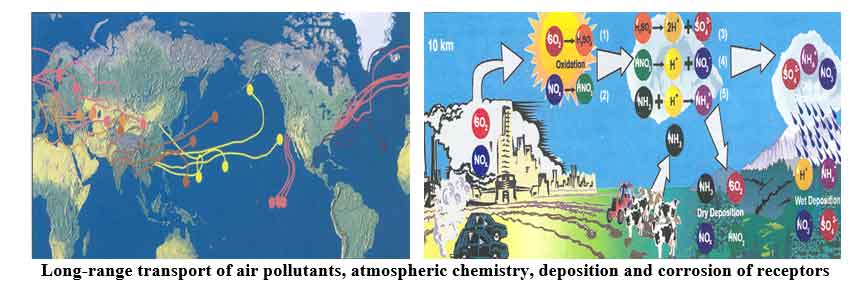
During transport, the acidic gases SO2 and NO2, may be partially neutralized if the edaphic source dust in the atmosphere is alkaline. The acidic gases may also convert into mild acids (H2SO4, HNO3) when they come into contact with water vapour. SO2 and NO2 (dry deposition), and H2SO4 and HNO3 (wet deposition)when deposited on the ground will over time impact soils, vegetation, water bodies, structures, human health and other sensitive receptors along the transport path.
Low pH soils lack the capacity to neutralize wet and dry depositions and, therefore will corrode and further acidify, making it inimical to vegetation in forests and croplands. Acidic deposition may also cause forest diebacks, as happened in the Harz Mountains in Germany between 1970 and 1986.
India’s best forests are on lateritic and low pH soils. Wet and dry deposition of acidic gases on the Western and Eastern Ghats, the lower Himalayan, Northeast Indian and Andaman forests are at risk of having forest diebacks.
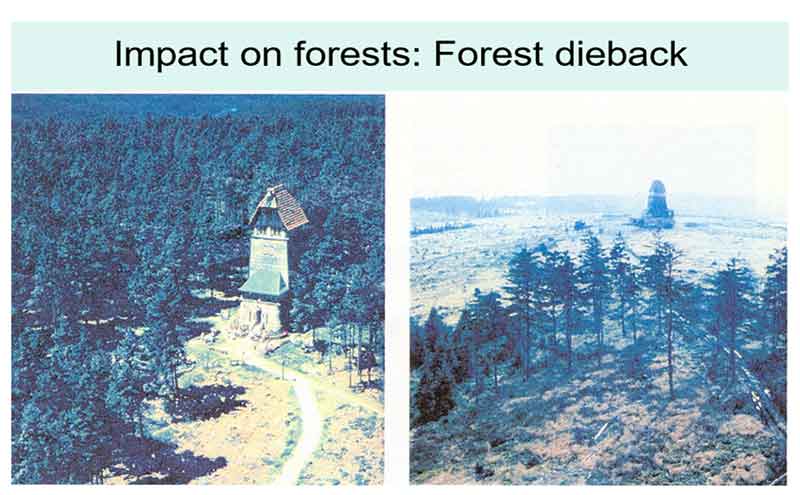
Forest dieback in India will put the water security of Indo-Gangetic plains, Central India and the Deccan Plateau at risk as the function of Indian forests to act as “water towers” will be compromised. With the forests’ capacity to regulate water flow in rivers, the Deccan Plateau will experience greater flooding during the monsoon—June to September, and longer periods of dry river beds in winter and summer—December to May.

Studies have estimated that South Asia will be one of the most affected regions by O3 due to NO2 emissions. Long-range transported acidic gases may reduce paddy yields in South India by 3-10%.

Acidic gases corrode structures as happened to those close to the Narla Tatarao Thermal Power Plant at Ibrahimpatnam in Andhra Pradesh.

Wet and dry deposition may also acidify water bodies, particularly lakes and ponds, making them inimical for aquatic ecology, as happened in Sweden. A pH drop of the waters of Sweden’s 15,000 lakes was first noticed in the 1950s. This turned serious over the next two decades when fish and other aquatic life in the lakes died to acidification of the lake’s water. Sweden had to treat its lakes to reverse the lake acidification caused by long range transport of acidic gases.
Aquatic organisms are sensitive to low pH in freshwater. Many species cannot tolerate water below pH 6. And below pH 5 all normal aquatic life is lost in water bodies, with invertebrates being the only largest set of remaining animals.
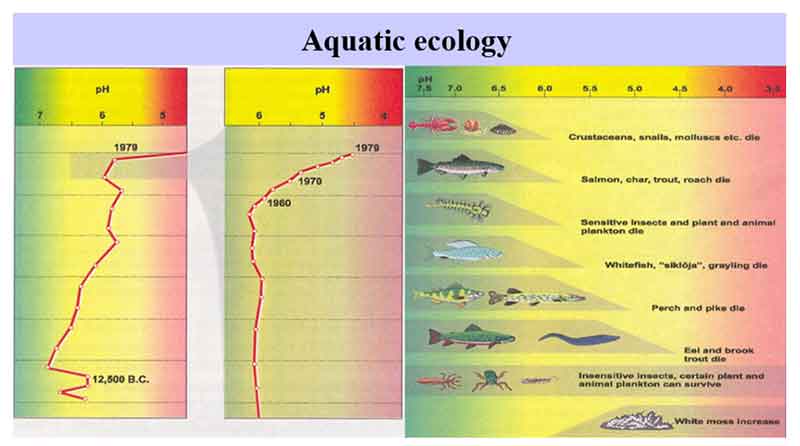
For eight months of the year, from October to May, the upper atmospheric winds over South Asia move northwest to southeast from over Afghanistan to Assam, where they take a near U-turn and move over the Deccan Plateau, before being stopped over the Maldives by the inter-tropical convergence zone (ITCZ) that acts like an air curtain. Pollutants are picked up and deposited all along wind pathway.

During the monsoon months, June to September, the upper air winds move in roughly the opposite direction as between the non-monsoon months. Greater dry deposition occurs during the non-monsoon months and more wet deposition during the monsoon months.
Since regional pollutant transport occurs over hundreds to thousands of kilometres, there is transboundary transport acidic gases. When their impacts become visible, a potential conflict situation between upwind and downwind countries may arise.
Climate Change
Global South will be disproportionately impacted by Climate Change: Climate change is disproportionately harming the Global South. Between 1970-2021, 91% of over 2 million deaths caused by extreme weather, climate and water-related disasters occurred in the Global South[ii]. Climate change has cost climate-vulnerable economies (68 V20 nations) about 20% of their GDP in the last two decades[iii].
South Asia will be hard hit: South Asia is particularly vulnerable to climate change impacts. It has a quarter of the world’s population but has emitted only 3.6% of the world’s cumulative emissions.
South Asia’s vulnerability is caused by two factors. The first is its geography. Its large land mass makes heat waves more severe, its river deltas promote increased sea rise, and increased snow and glacier melt with warming will decrease water flow in snow-fed rivers and consequently cause water stress.
The second is its low economic and material development that makes its population less resilient to meet climate change impacts. Its current per capita GDP (US$ 2,287 in 2022) is a sixth of the global average (US$ 12,688 in 2022) and its low per capita energy use, reflected in low per capita CO2 emissions is less than a third of the global average (2022 global per capita–energy use = 1.93 toe/per person, CO2 emissions = 4.7 tCO2/person).
The more prominent global warming impacts are sea rise, water stress, glacial lake outburst floods (GLOFs) and extreme weather events.
Sea Rise
Sea rise will hit Bangladesh and Maldives the hardest even though their contribution to global warming is miniscule. The emissions of these countries are 0.1% and <0.01% of the world’s cumulative CO2 emissions, respectively. Their CO2 emissions were 0.24% and 0.004% of the world’s CO2 emissions in 2017.
A combination of several factors has contributed to an observed sea rise of 2.8-8.8 mm per annum[iv] in the Sundarbans area of Bangladesh. This is significantly higher than the global average sea rise of 2.8-3.2 mm per annum[v] observed for the period 1990-2009. A large portion of the Sundarbans mangrove forests in Bangladesh will be under the sea by 2100.
Sea ingress will turn surface and groundwater saline in the Sundarbans. Consequently, agriculture, fisheries and other livelihoods will be affected. Human and animal habitats, domesticated animals and wildlife will be lost. As global temperatures rise, the intensity of cyclones hitting Bangladesh will increase, and there will be a greater number of extreme weather events. Cyclone Remal battered the Sundarbans coast in Bangladesh and West Bengal in May 2024 is a good example of nature’s fury that will be seen in future. Ten lakh persons in Bangladesh and another 2 lakhs in India had to be evacuated from the coast to put them out of harm’s way. With sea rise, the mangroves of the Sundarbans forest will erode, and the protection they offer against storm surges during cyclones will diminish.
Fifty million Bangladeshi climate refugees will leave the country[vi] by 2050. That number will double by the end of the 21st Century. Being extremely poor, these climate refugees will be forced to migrate within and outside Bangladesh, causing considerable stress and possible conflict in South Asia. The displaced population would have lost their livelihood, and as refugees they will be at greater risk to falling ill, and be subject to indignity and abuse—child trafficking, etc.

By 2100, Maldives will become all but uninhabited as sea rise will drown almost the entire island state, as 80% of the Maldive islands lie below 1 m above mean sea level (AMSL). The entire population of Maldives will become climate refugees (current population ~500,000).
Water Stress
Despite their very small contribution to global warming, Afghanistan, Pakistan and Sri Lanka will be severely water-stressed, and by 2040-50 will be at high risk of having repeated and severe droughts. The cumulative CO2 emissions of Afghanistan, Pakistan and Sri Lanka are 0.01%, 0.3% and 0.03% of the world’s cumulative emissions, respectively and their CO2 emissions in 2017 were 0.04%, 0.55% and 0.06% of the world’s CO2 emissions. Yet, the regions above Herat and Islamabad, around Karachi, and southern Sri Lanka, will be particularly severely water-stressed. The population at risk of hunger is expected to be 38.1%, 12,6% and 17.7% in Afghanistan, Pakistan, and Sri Lanka, respectively.
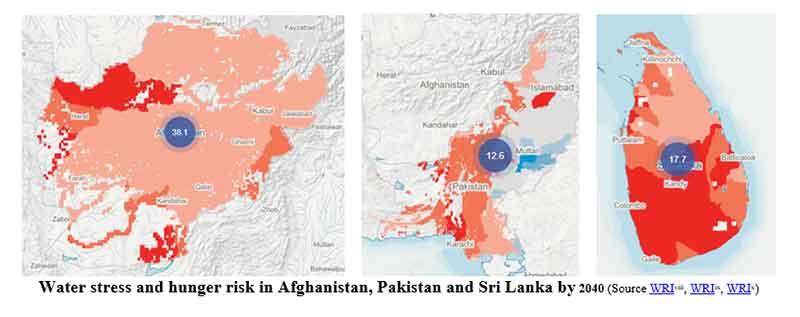
Global warming is expected to significantly impact snow and glacier melt in the Himalayas[xi]. As the glaciers melt, they will initially cause an increase in meltwater in snow-fed rivers, followed by a decline. While glacial meltwill impact all the major snow-fed South Asian rivers, its impact on the Brahmaputra and the Ganga will be less as the glacial and snow melt contribute only 8-21% of their discharge, whereas the Indus and the Amu Darya will be greater as their dependence on glacial and snow melt is 60-77%.
Basin characteristics and snow/glacier melt contribution to downstream discharge
| Parameter | Ganga | Brahmaputra | Indus | Amu Darya |
| Mean discharge (m3/sec) | 18.691 | 19,824 | 5,533 | |
| Snow and glacier melt contribution to downstream discharge (%)[xii] | 8.7 | 21 | 60 | 77 |
| Irrigated area (km2) | 156,300 | 5,989 | 144,900 | 450 |
(Source: For Ganga, Brahmaputra and Indus see Ref [xiii], for Amu Darya see Ref [xiv])
As the water discharge in the Indus and the Amu Darya decrease, large parts of Pakistan and the northeastern parts of Afghanistan will become severely water-stressed and the food and water security of an estimated 60 million people will be compromised[xv]. The future of the people from these regions is not well understood. It is not beyond the realm of possibility that if adequate food and water aid and alternative livelihoods are not provided, these regions may generate climate refugees.
Pakistan is critically dependent on the Indus as it is the only major river it has. Even a decrease of 5% of the Indus flow will impact Pakistan’s agriculture and farm incomes, nutrition standards, and the economy. In the coming decades as the water flow in the Indus decreases, Pakistan’s Sindh and Punjab provinces may come into conflict over water sharing, akin to the water conflicts between Karnataka and Tamil Nadu over the Cauvery River water. Upper and lower riparian states are in conflict in many parts of the world over many inter-state rivers, e.g., the Jordan River, the Tigris and Euphrates, the Nile.
If Pakistan is destabilized because of a potential conflict between two of its provinces, it will have a domino effect on all of South Asia. The world will then have to worry about the fate of Pakistan’s strategic assets and the various possible risk scenarios that may arise.
Glacial Lake Outburst Floods
On 3 October 2023, the moraine dam responsible for creating the South Lohnok Lake (5,200 m AMSL) in Upper Sikkim, gave way to cause a GLOF. The flood waters killed at least 44 persons, triggered a landslide 30 km downstream of the lake and damaged three dams and hydroelectric projects on the Teesta River that are over 65 km from the lake.
As a glacier melts, the water volume in the lake at its mouth increases and exerts greater pressure on the moraine dam (consisting of rock and debris) that holds the lake. At some point the dam breaks and releases millions of tonnes of water, causing a GLOF. Villages, fields, and everything else up to 100 km downstream of the glacial lake are washed away.
With climate change, the frequency of GLOF occurrence is expected to increase in the Himalayas. A recent study[xvi] compiled an inventory of 62 GLOFs that have occurred in the Himalayas in the last 80 years. Of these, 39 GLOFs could be given a date. The table indicates that GLOF frequency has increased in recent times.
Frequency of GLOF occurrence in the last century (Source: Ref xxxiv)
| Time period | Central Himalayas | Eastern Himalayas | Per cent occurrence |
| Nos | Nos | % | |
| 1930-39 | 1 | 3 | |
| 1940-1959 | 0 | 5 | 13 |
| 1960-79 | 7 | 2 | 23 |
| 1980-1999 | 9 | 4 | 33 |
| 2000-2019 | 8 | 3 | 28 |
| Total | 25 | 14 | 100 |
Bhutan and Nepal each with cumulative CO2 emissions that is less than 0.01% of the world’s cumulative emissions and current CO2 emissions of 0.003% and <0.01% of the world’s current emissions, will be the countries most vulnerable to GLOFs.
Extreme Weather Events
With a population that is 17.8% of the world’s population, India’s contribution to global cumulative and current emissions are as little as 3.2% and 6.8%, respectively. Yet, India will be impacted by many climate change impacts—sea rise, water stress, GLOFs, extreme weather events (abnormally high temperatures or precipitation), floods, drought, cyclones, significant crop yield losses, heat stress, etc. Of these, a large number of extreme weather events occurred in India in the last 15 years. As warming intensifies, more such events will happen.
Extreme weather events in India in the 21st Century
| Year | Event | Location | Estimated deaths |
| 2005 | Very heavy rainfall | Mumbai | 1,100 |
| 2013 | Cloudburst | Kedarnath | >5,000 |
| 2015 | Very heavy rainfall | Chennai | 500 |
| 2018 | Heatwave | All over India | 2,405 |
| 2018 | Very heavy rainfall | Kerala | 500 |
| 2019 | Very high temperatures | Maharashtra, MP | 50 |
| 2019 | Heavy rainfall & floods | Maharashtra, Karnataka, Goa, Kerala | ~300 |
| 2020 | Heavy rainfall & floods | Hyderabad | 50 |
A large number of lives were lost in the 2013 Kedarnath cloudburst and in the 2018 very heavy rainfall event in Kerala. Landslides occurred in hill plantation areas of Kerala as they lacked the soil gripping capacity of forests, leading to loss of life.
High temperatures cause heat stress, whose direct effects are fatigue and heat stroke; and the indirect effects are reduced work performance, increased accidents, reproductive problems, heart and lung strain, and increase in disease-carrying vectors. A study[xvii] on heat stress and mortality done in Surat concludes that “There is an increase of 11% all-cause mortality when temperature crossed 40oC.” Another recent study[xviii] established a correlation between high temperatures and chronic kidney disease (CKD) in rural areas. To arrive at its conclusions, it reviewed studies in several continents—Asia, North and South America and Africa.
Some Causes for South Asia’s Environmental Challenges are Extraneous
Some causes contributing to the potential for conflicts over inter-state river water sharing, transboundary air pollution and the climate change impacts are extraneous to South Asia. Chief among them is Great Britain’s motivation to partition the Indian subcontinent, and the Global North being the main contributor to cumulative CO2 emissions. Yet, South Asia has to tackle these challenges largely on its own as help from the Global North is not very forthcoming.
Partitioning Indian Subcontinent: The partitioning of India is at the root of the potential future conflicts between India-Pakistan and India-Bangladesh over inter-state river water sharing and transboundary air pollution.
The British partitioned the Indian Subcontinent in 1947 not only because the Muslim League asked for a separate homeland for Muslims but also for strategic reasons, but also because West Pakistan was strategically located. It borders Iran, Afghanistan and China and is very close to the Soviet Union, none of whom, except Iran, were friendly to Britain and the West. The British feared that the Congress party, with a left-of-centre leadership, would move a united India away from the Commonwealth and closer to the Soviet Union. The Muslim League was always friendly with the British, hence Great Britain felt that a Muslim League-led Pakistan would be favourable to the Commonwealth and would make Pakistan a buffer state between the Congress-led India and the Soviet Union.
Had the Indian Subcontinent not been partitioned, the potential for conflicts over river water sharing between India-Pakistan and India-Bangladesh, and long range transported pollutants would be akin to the Cauvery River water dispute, i.e., a dispute within the same country, and therefore more amenable to a solution. River water sharing between Nepal and India and transboundary air pollution issues in the Indian Subcontinent have still to be addressed.
Global North and the super-rich are primarily responsible for climate change: With a sixth of the global population, the Global North emitted twice the cumulative CO2 emissions of the Global South. The per capita cumulative CO2 emissions of Global North, Global South and India are 1,259, 127 and 53 tCO2/person[xix], respectively. That CO2 is a greenhouse gas has been known for over a century. Consequently, the Global North is responsible for pouring out a major fraction of the cumulative CO2 emissions.
Much of the Global North (Europe, USA, Canada, Australia, New Zealand) used fossil fuels for 300 years to industrialize and raise their material standard of living. Japan, South Korea, Israel and French Guiana, which are also part of the Global North, did the same but in a much shorter period. The Global North had an average per capita GDP US$ 44,787 in 2018, ten-fold greater than that of the Global South (US$ 4,971), and twenty times that of South Asia (US$ 1,903). The Global South began to industrialize after the mid-20th Century.
The trend of the rich dumping a grossly disproportionate amount of CO2 continues to date. The document Climate Equality: A Planet for the 99%[xx] concludes that:
- In 2019, the super-rich 1% were responsible for 16% of global carbon emissions, which is the same as the emissions of the poorest 66% of humanity (5 billion people). The bottom 50% were responsible for only 8% of the emissions.
- Since the 1990s, the super-rich 1% burned through twice as much of the carbon budget as the poorest half of humanity combined.
- The emissions of the 1% are set to be over 22 times more than the safe limit (the emissions allowed if we are to stay below 1.5°C global warming) in 2030.

That CO2 causes warming has been known since 1896, ever since Arrhenius published the first calculation of global warming from human emissions of CO2. Since then, scientists have continuously improved their understanding of carbon emissions impacts. In 1956 Plass calculated that adding CO2 to the atmosphere would have a significant effect on the radiation balance, and in 1960 Keeling accurately measured CO2 in the Earth’s atmosphere and detected an annual rise.
Yet, CO2 emissions have not been controlled and are still rising as corporations are motivated by gain maximization (profits) for themselves and not risk minimization for society.
Sharing Inter-state River Waters Equitably
River water disputes between states or countries go through three stages. In the first stage, there is no dispute or it is insignificant as water is plentifully available.
In the second stage, a water-sharing dispute arises between upper and lower riparian states as water use has increased. Attempts are made to resolve the dispute through dialogue, adjudication or arbitration, diplomacy and third-party mediation. One or both sides may issue threats to resolve the dispute by military means. The Indus Water Treaty and the Treaty on Sharing Ganga Waters are products of water-sharing arrangements between India-Pakistan and India-Bangladesh.
In the third stage when the water-sharing agreement is no longer acceptable to one or both sides, military action ensues after all dispute-resolution mechanisms fail. One of the primary reasons for the June 1967 Six-day war between Israel and the Arabs was over their Jordan River. By occupying the Golan Heights in Syria on the eastern bank of the Jordan River, and the West Bank, then under Jordan’s control, Israel secured Jordan River’s water for itself.
The effort to halt global warming has not succeeded till date. As warming increases, large parts of South Asia will become parched. Though water-depleted due to glacial melt, the Himalayas will remain a major water source for South and East Asia.
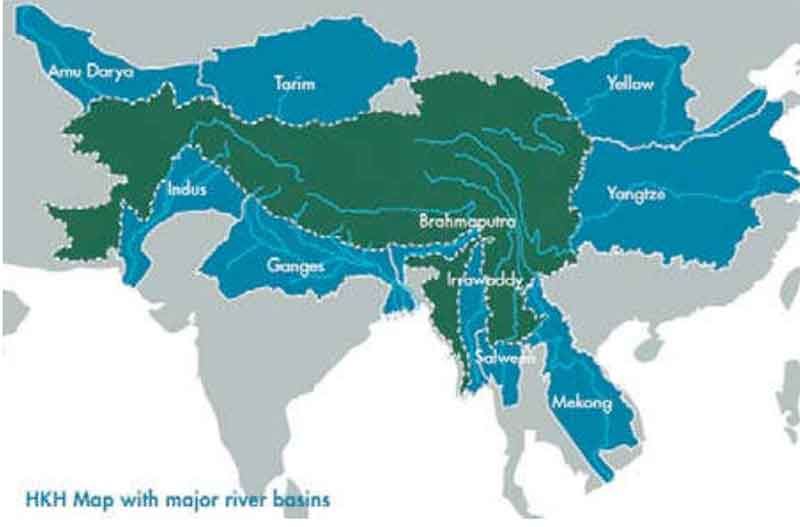
The Himalayan Water Tower
To avoid such an eventuality, which can be quite disastrous, treaties should be negotiated between South Asian countries to arrive at a rational and equitable sharing of inter-state river waters.
Air Emissions Protocol
To control transboundary transport of air pollutants. South Asian countries should sign a protocol along the lines of the 1999 Gothenburg Protocol signed by the European Union (EU) member states. The Gothenburg Protocol set air pollutants emissions reduction commitments for EU member states for 2010. This was subsequently amended in 2012 to set new commitments for 2020. The air pollutants covered by the protocol are the main pollutants (SOx, NOx, NH3, CO and non-methane VOCs), heavy metals (Pb, Hg, As, Cr, Cu, Ni, Se, Zn), persistent organic compounds and individual polycyclic hydrocarbons.
South Asian countries may initially cover SOx, NOx and NH3 under an emissions control protocol, and subsequently add other pollutants to the protocol.
However, air emissions control in South Asia may be regarded as an anti-development measure. Scientists must convince South Asia that air emissions control will improve quality of life which in turn will improve labour productivity and also save medical costs. Moreover, a South Asia air emissions protocol will avoid future conflicts between South Asian nations.
Under the Malé Programme, the United Nations Environment Programme (UNEP), set up wet and dry deposition monitoring stations in Iran and all the South Asian countries, except Afghanistan. Data from this programme should be available in the public domain. This data will indicate the extent to which transboundary transport of air pollutants in South Asia has impacted the environment.
Climate Cooperation
Climate Finance: One of the most important factors in tackling climate change is finance. It is required, particularly by the Global South, for three intents—a) for mitigation, i.e., reducing carbon emissions, e.g., by transiting to alternate energy sources such as solar and wind energy, etc; b) for adaptation, i.e., for adjusting to change in the climate, e.g., shifting to heat resistant crops, deploying low-cost heat load reduction technologies to cool homes, etc; c) for compensating the loss and damage caused by climate change, i.e., making restitution for the injury caused by climate change, e.g., rebuilding homes and livelihoods lost due to floods, rehabilitating climate refugees, etc.
The Global North must provide the Global South with climate finance, particularly for adaptation and loss and damage, as the North is primarily responsible for climate change, and also because the South is more vulnerable and lacks resources.
How much climate finance is required by the Global South? The Emerging markets and developing countries, excluding China, will need an additional US$ 1 trillion per year by 2025 (4.5% of their GDP), beyond domestic funding, as climate finance, and US$ 2.4 trillion per year 2030 onwards (6.5% of GDP) for mitigation, adaptation, and loss and damage[xxi]. By 2030, the annual economic cost of loss and damage alone is estimated to be between US$ 290-580 billion (mean US$ 435 billion pa) in developing countries[xxii]. The estimated annual adaptation costs for developing countries are in the range of US$ 215-387 billion (mean US$ 301 billion pa) in this decade[xxiii], which is 10-fold greater than the adaptation funds flowing to the Global South today.
How much climate finance is available? At the 2009 Copenhagen COP15 meeting, developed countries committed to mobilising US$ 100 billion per year for the Green Climate Fund (GCF) by 2020 for climate financing developing countries. That target was met only in 2022[xxiv]. Moreover, most climate finance has gone for mitigation in middle-income countries, and not adaptation in low-income countries[xxv].
Besides the GCF, four other funds were set up. The Special Climate Change Fund was established in 2001 to finance adaptation; technology transfer and capacity building; energy, transport, industry, agriculture, forestry and waste management; and economic diversification. The Least Developed Countries Fund was established in the early 2000s to support and assist Least Developed Country Parties to prepare and implement their national adaptation programmes. The Adaptation Fund was established in 2001 to finance concrete adaptation projects and programmes in developing country. Virtually no provision was made for compensation or reparations to the climate vulnerable countries for loss and damage they have already suffered till the Loss and Damage Fund was created in the 2022 COP 27 in Sharm el-Sheikh.

Climate finance provided and mobilised in 2013-2022 (US$ billion)
Source: OECD, Climate Finance Provided and Mobilised by Developed Countries in 2013-2022xxiii
Barring the GFC, the other funds have little money. The Global North continue to reject any formal recognition of liability or responsibility for providing compensation. Some North countries insist that contributions to the fund be voluntary, which undermines the chances that the fund will receive sufficient resources.
The resources available for climate financing, which is a little over US$ 100 billion, is a small fraction of the required US$ 2.5 trillion annually.
Climate Action Cooperation: Climate justice requires that nations take responsibility for climate change impacts—displacement of people, property loss, etc, attributable to them in proportion to their cumulative emissions and that the risks caused and the benefits accrued due to the use of fossil fuels be shared equitably, i.e., such mitigative and adaptive measures be put into place such that all people of the world face roughly the same degree of risk from the impacts of GHG emissions, e.g., the Global North pay for migrating vulnerable populations from Small Island Nations and coastal Bangladesh to safer locations in Europe, North America and Australia; and the wealth created by the use of fossil fuels are distributed equally to all people of the world.
The Global North refuses of take responsibility for its cumulative emissions for fear of opening the floodgates of compensation litigation. As the Global North’s contribution to climate finance is far short of the Global South’s requirement, the latter has to fend for itself. And the best way to do this is through a South-South cooperation.
South Asia has a quarter of the world’s population today, but its cumulative CO2 emissions are only 3.6% of that of the world, and its current emissions are 7.2% of that of the world. Yet, it is one of the two most vulnerable regions in the world to climate change impacts. South Asian countries, including India, lack the financial and the human resources required to tackle climate change on their own. To tackle climate change, South Asian countries must therefore cooperate and pool their resources. Lack of adequate climate finance is an added reason to do this.
To improve their ability to deal with the ravages of climate change South Asian countries must can pool their financial, material and human resources. For example, recent climate-related impacts in South Asia, e.g., the August 2022 Pakistan floods, that submerged a third of the nation, killed more than 1,000 people and displaced 33 million people, could have been managed much better if there had been greater cooperation in South Asia.

Likewise, heat stress will be a big killer in South Asia. The 2024 summer has seen prolonged heatwave conditions all over mainland South Asia. Temperatures in many places exceeded 45oC, and in a few places even 50oC. Low-cost heat reduction technologies for urban slums and rural housing and heat action plans for urban and rural areas could be shared in South Asia.
The carbon cycle has been disturbed. It cannot be fixed unless all nations cooperate. South Asia can emulate the example of the European Union in setting up cooperative programmes to tackle climate change.
South Asian Union
A good way for South Asian countries to cooperate is to go beyond the existing South Asian Association for Regional Cooperation (SAARC) and form a South Asian Union (SAU) along the lines of the European Union. The SAU could have a single currency and allow for visa-free travel within the SAU. This is not a new idea. The formation of a SAU will allow for greater economic cooperation, cultural exchange, a reduction in arms spending by guaranteeing mutual security, phasing out of weapons of mass destruction, cooperation on resource sharing, addressing climate change, and avoiding environmental conflicts.
The spirit of Vasudaiva kutumbakam (the world is one family) that has flourished in South Asia for millennia should be embraced in South Asia along with the concept of “One earth, one family, one future” that India, as the president of the GO20, popularized in its September 2023 Delhi summit.
Since SAARC has remained inactive for several years, the people of South Asian countries must now take the initiative to ask their governments to initiate discussions for the formation of a South Asian Union. It is in South Asian people’s interest to have a SAU.
A move in that direction was made when about 50 persons from Nepal, India, Pakistan and Sri Lanka under the aegis of the South Asian People’s Friendship Association met in Kathmandu during the World Social Forum on 16-17 February 2024 and recommended the following measures be adopted by South Asian countries to reduce environmental conflicts and engender greater cooperation to mitigate the impacts of the climate crisis in South Asia.
- Alternative development models that may decrease potential environmental conflict should be discussed. Such discussions should be had both by experts and by the public.
- Upstream polluting industries should follow environmental regulations strictly.
- Measures (do’s and don’ts) to avoid environmental conflicts should be devised.
- The formation of a South Asian Union would help reduce the potential environmental conflicts and engender greater cooperation among South Asian nations to tackle the climate crisis.
- Youth should be mobilized to engender greater cooperation between South Asian nations.
- A list of points should be prepared for the people of South Asia to lobby with their respective governments to reduce potential environmental conflicts and increase cooperation in tackling the climate crisis.
- A method for monitoring potential environmental conflicts and cooperation on environmental programmes should be devised.
- Climate and peace should be the theme of this effort.
- Sharing of natural resources by South Asian nations should be equitable.
- South Asia Co-operative Environment Programme (SACEP), an inter-governmental organization, established in 1982 by the governments of South Asia to promote and support protection, management and enhancement of the environment in the region, should be revived. Public participation in SACEP’s governance and programmes should be mandated.
Sagar Dhara is a Male; Upper class & caste; College-educated; City-slicker; Member of the most ferocious predator that stalked Earth—humans. Email: [email protected]
[ii] https://public.wmo.int/en/media/press-release/economic-costs-of-weather-related-disasters-soars-early-warnings-save-lives
[iii] Vulnerable Twenty Group. (2022). Climate vulnerable economies loss report, https://www.v-20.org/wp-content/uploads/2022/06/Climate-Vulnerable-Economies-Loss-Report_June-14_compressed-1.pdf
[iv] Pethick, J., Orford, J. D., 2013. Rapid rise in effective sea-level in southwest Bangladesh: Its causes and contemporary rates, Global and Planetary Change 111 (2013) 237–245. 10.1016/j.gloplacha.2013.09.019. Accessed on 120 January 2019 from https://www.researchgate.net/publication/259135167_Rapid_rise_in_effective_sea-level_in_southwest_Bangladesh_Its_causes_and_contemporary_rates
[v] Coastal wiki accessed on 19 January 2019 from http://www.coastalwiki.org/wiki/Sea_level_rise
[vi] Gardiner, H., Borrowed time on disappearing land, The New York Times, 28 March 2014. Accessed on 19 January 2020 from https://www.nytimes.com/2014/03/29/world/asia/facing-rising-seas-bangladesh-confronts-the-consequences-of-climate-change.html?_r=0
[vii] Climate Central. Accessed on 19 January 2020 from http://sealevel.climatecentral.org/maps
[viii] World Resource Institute. Accessed on 1 February 2020 from https://www.wri.org/applications/aqueduct/food/#/?basemap=hydro&country=AFG&crop=all&food=ee0aefe6-176e-43e7-b349-b44b70d95d22&indicator=d8439b5e-c7f0-4021-9347-f1e68ef8122e&irrigation=all&lat=34.05&lng=67.15&opacity=1&period=year&period_value=baseline&scope=country&type=change_from_baseline&year=2040&zoom=6
[ix] World Resources Institute. Accessed on 1 February 2020 from https://www.wri.org/applications/aqueduct/food/#/?basemap=hydro&country=PAK&crop=all&food=ee0aefe6-176e-43e7-b349-b44b70d95d22&indicator=d8439b5e-c7f0-4021-9347-f1e68ef8122e&irrigation=all&lat=30.60&lng=67.85&opacity=1&period=year&period_value=baseline&scope=country&type=change_from_baseline&year=2040&zoom=5
[x] World Resources Institute. Accessed on 1 February 2020 from https://www.wri.org/applications/aqueduct/food/#/?basemap=hydro&country=LKA&crop=all&food=ee0aefe6-176e-43e7-b349-b44b70d95d22&indicator=d8439b5e-c7f0-4021-9347-f1e68ef8122e&irrigation=all&lat=7.89&lng=80.50&opacity=1&period=year&period_value=baseline&scope=country&type=change_from_baseline&year=2040&zoom=7
[xi] Immerzeel, W.W., van Beek, L.P.H., Bierkens, M.F.P., 2010. Climate change will affect the Asian water towers Science 328 1382–5. Accessed on 29 January 2020 from https://www.futurewater.es/wp-content/uploads/2011/05/Immerzeel_Science_11June2010.pdf
[xii] Data for Ganga, Brahmaputra and Indus are from Ref xxv, and for Amu Darya is from Ref xxviii. It is important to note that the discharge figures for Amu Darya is for elevations >2,000 m, whereas the figures for Ganga, Brahmaputra and Indus are for total discharges. While the contribution of snow and glacier melt as a fraction of discharge that is quoted in this paper is probably higher than for the total discharge of this river, as much of the Amu Darya drainage is in the Pamir mountains whose elevations are >1,000-2,000 m. The figure quoted in this paper provides the reader with an approximate idea of the probable percentage contribution of snow and glacier melt to this river.
[xiii] Shea, J.M., Imerzeel, W.W., Wagnon, P., Vincent, C., Bajracharya, S.. Modeling Glacier Change in the Everest Region, Nepal, Himalaya, The Cryosphere, 9, 1105–1128, 2015 www.the-cryosphere.net/9/1105/2015/ doi:10.5194/tc-9-1105-2015. Accessed on 29 January 2020 from https://www.the-cryosphere.net/9/1105/2015/tc-9-1105-2015.pdf.
[xiv] Armstrong, R.L., Rittger, K., Brodzik, M.J., Racoviteanu, A.R., Barrett1, A.P., Khalsa, S-J.S., Raup, B., Hill, A.F., Khan, A.F., Wilson, A.M., Kayastha, R.B., Fetterer, F., Armstrong, B., 2019. Runoff from glacier ice and seasonal snow in High Asia: separating melt water sources in river flow, Regional Environmental Change (2019) 19:1249–1261. https://doi.org/10.1007/s10113-018-1429-0. Accessed on 2 February 2020 from https://link.springer.com/article/10.1007/s10113-018-1429-0
[xv] Immerzeel, W.W., van Beek, L.P.H., Bierkens, M.F.P., 2010. Climate Change Will Affect the Asian Water Towers, DOI: 10.1126/science. 1183188, Science 328, 1382 (2010). Accessed on 29 January 2020 from https://science.sciencemag.org/content/328/5984/1382
[xvi] Nie, Y., Liu, Q., Wang, J., Zhang, Y., Sheng, Y., Liu, S., 2018. An inventory of historical glacial lake outburst floods in the Himalayas based on remote sensing observations and geomorphological analysis, Geomorphology. 308. 10.1016/j.geomorph.2018.02.002. Accessed on 1 February 2020 from https://www.researchgate.net/publication/322986492_An_inventory_of_historical_glacial_lake_outburst_floods_in_the_Himalayas_based_on_remote_sensing_observations_and_geomorphological_analysis Geomorphology. 308. 10.1016/j.geomorph.2018.02.002
[xvii] Desai, V.K., Wagle, S., Rathi, S.K., Patel, U., Desai, H.S., Khatri, K., 2015. Effect of ambient heat on all-cause mortality in the coastal city of Surat, India, Current Science, 109(9), 10 November 2015. Accessed on 1 February 2020 from https://www.currentscience.ac.in/Volumes/109/09/1680.pdf
[xviii] Glaser, J., Lemery, J., Rajagopalan, B., Diaz, H.F., Garcı´a-Trabanino, R., Taduri, G., Madero, M., Amarasinghe, M., Abraham, G., Anutrakulchai, S., Jha, V., Stenvinkel, P., Roncal-Jimenez, C., Lanaspa, M.A., Correa-Rotter, R., Sheikh-Hamad, D., Burdmann, E.A., Andres-Hernando, A., Milagres, T., Weiss, I., Kanbay, M., Wesseling, C., Sa´nchez-Lozada, L.G., Johnson, R.J., 2016. Climate Change and the Emergent Epidemic of CKD from Heat Stress in Rural Communities: The Case for Heat Stress Nephropathy, Clin J Am Soc Nephrol 11: 1472–1483, 2016. doi: 10.2215/CJN.13841215. Accessed on 1 February 2020 from https://cjasn.asnjournals.org/content/clinjasn/11/8/1472.full.pdf
[xix] Per capita cumulative emissions are computed by dividing the cumulative emissions (1751-2017) of a country/region by the current population.
[xx] Oxfam, 2023, Climate Equality: A planet for the 99%, https://policy-practice.oxfam.org/resources/climate-equality-a-planetfor-the-99-621551/.
[xxi] Songwe. V., Stern. N., Bhattacharya. A., 2022. Finance for climate action: Scaling up investment for climate and development. London: Grantham Research Institute on Climate Change and the Environment, London School of Economics and Political Science. https://www.lse.ac.uk/granthaminstitute/wp-content/uploads/2022/11/IHLEG-Finance-for-Climate-Action-1.pdf.
[xxii] Anil Markandya and Mikel González-Eguino, “Integrated Assessment for Identifying Climate Finance Needs for Loss and Damage from Climate Change”, in Mechler R., Bouwer, L., Schinko, T., Surminski, S. Linnerooth-Bayer, J. (eds), Loss and Damage from Climate Change: Concepts, Methods, and Policy Options, (Springer, Cham, 2019).
[xxiii] United Nations Environment Programme (2023). Executive summary. In Adaptation Gap Report 2023: Underfinanced. Underprepared. Inadequate investment and planning on climate adaptation leaves world exposed. Nairobi.
[xxiv] OECD, (2024). Climate Finance Provided and Mobilised by Developed Countries in 2013-2022, https://doi.org/10.1787/19150727-en.
[xxv] OECD (2022), Climate Finance Provided and Mobilised by Developed Countries in 2016-2020: Insights from Disaggregated Analysis, Climate Finance and the USD 100 Billion Goal, OECD Publishing, Paris.

